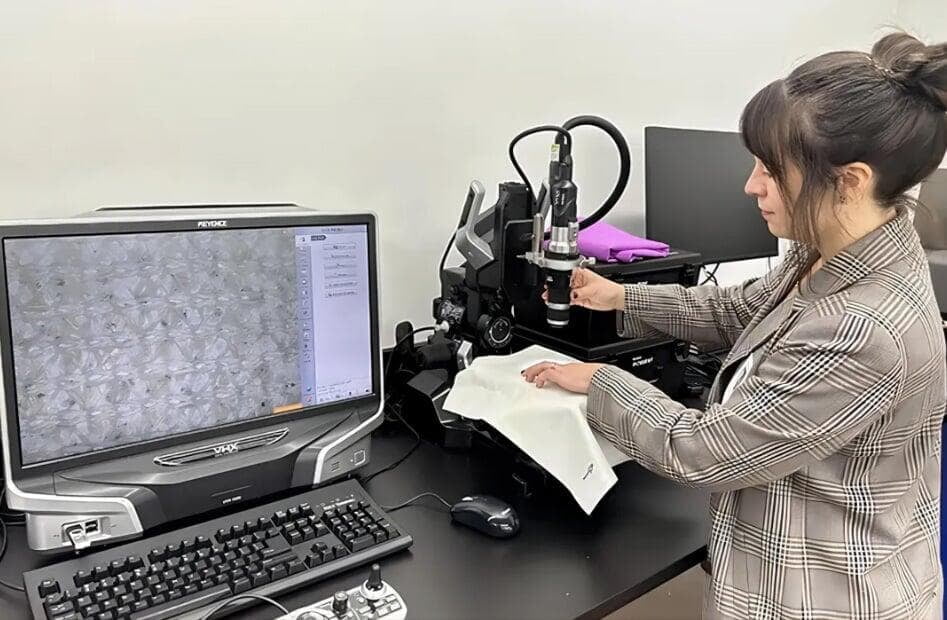Recently, DOE's Bio-Optimized Technologies for Keeping Thermoplastics Out of Landfills and Out of the Environment (BOTTLE) scientists, including a team from the National Renewable Energy Laboratory (NREL) and Colorado State University, developed a series of PHAs with different properties, some of which are similar to those of conventional polyesters, but with biobased, biodegradable and more easily recyclable.
The team is working with leading outdoor apparel brand The North Face to introduce these sustainable materials to the outdoor apparel industry. Over the next 12 months, BOTTLE will scale up the manufacturing process to produce several pounds of PHA fibers, which The North Face will test and evaluate for use in their production line. Clothing sheds when worn, washed and dried, and the tiny fibers are dispersed in homes, soil and waterways, taking centuries to degrade. These fibers, often made of polyester, are so tiny as to be hard to detect and are a major - though invisible - source of microplastic pollution. Fibers from polyester clothing are estimated to account for nearly half of all microplastics in the natural environment, exacerbating a growing environmental and public health hazard, said Katrina Knauer, chief technology officer and polymer scientist at the BOTTLE consortium. “PHAs can also break down naturally in composting environments that are not highly controlled.” Just a few years ago, research on whether PHAs could be made into textiles was inconclusive. Early production methods extracted PHA from bacterial synthetics, many of which naturally produce the polymer when digesting plant extracts such as glucose and fatty acids.NREL said in a press release that while this method was noteworthy at the time, it was difficult for scientists to control the backbone and properties of PHA.
As part of the mission to create more sustainable plastics, BOTTLE scientists developed alternative technologies to convert succinic acid (made from glucose and scientifically known as succinic acid) and other biobased substrates into PHA via a synthetic pathway. chemocatalytic methods enabled the team to customize the chemical backbone of the PHA to achieve key attributes, such as melt-processability, crystallinity and ductility.
The PHA prototypes have a wide range of properties - from rigid PHA polymers for clear food packaging to tough varieties for spinning into fibers, reports BOTTLE. “We are actually demonstrating that we can control the microstructure to make PHAs behave like polyester fibers and textiles,” says Knauer. Unlike conventional polyester, a petroleum-based textile that accounts for more than half of the fabrics produced each year, BOTTLE PHAs are also designed for recycling. At the end of a product's useful life, BOTTLE's chemical recycling technology breaks down PHAs and other polymers into chemical building blocks that are pure enough to be used in the manufacture of the highest quality plastics.”
According to Ravikumar Gowda, a BOTTLE researcher at Colorado State University, the material's recyclability depends on specific changes to the chemical backbone of PHA. By replacing reactive hydrogen atoms with robust alkyl groups, Gowda and other researchers at Colorado State University have greatly improved the thermal stability of PHA, making it melt-processable-a key advantage over PHA derived from microorganisms. Importantly, this change also allowed the research team to deconstruct the polymer at will.” He said, “Our redesigned PHA structure greatly improves mechanical toughness and requires only a simple catalyst and heat to enable the new PHA to recover its constituent monomers through a chemical reaction.” He said, “The recovered monomers can be reused, and in principle the same PHA can be produced an unlimited number of times.”

BOTTLE's partnership with The North Face comes at a time of growing concern about the environmental impact of making and wearing clothing. The textile production supply chain is estimated to be responsible for 8-10% of global CO2 emissions.
Therefore, the project prioritizes analysis to understand the energy and carbon intensity of manufacturing and recycling PHA fibers. The team will also simulate microfiber shedding and measure its biodegradation rate under various environmental conditions. These results will inform The North Face about the sustainability of PHA textiles in comparison to traditional polyester, the press release added.” We are committed to making the best performing products while leaving an ever smaller footprint on the planet,”
Carol Shu, Senior Manager of Global Sustainability at The North Face, said, “Material innovation is at the pinnacle of our brand, and this project not only opens up new possibilities for synthetic textiles, but also supports us in achieving product recycling.” After reviewing the initial results of BOTTLE, The North Face intends to test prototype fibers with its suppliers to evaluate a range of more sustainable products. “To make garments that look great, feel comfortable and perform in the harshest outdoor conditions, our goal is to find the perfect PHA fiber that matches or even improves upon the qualities consumers value most. Most importantly, it allows adventurers to climb peaks, run trails and explore cities with the confidence that no trace of microplastics will be left behind.”

